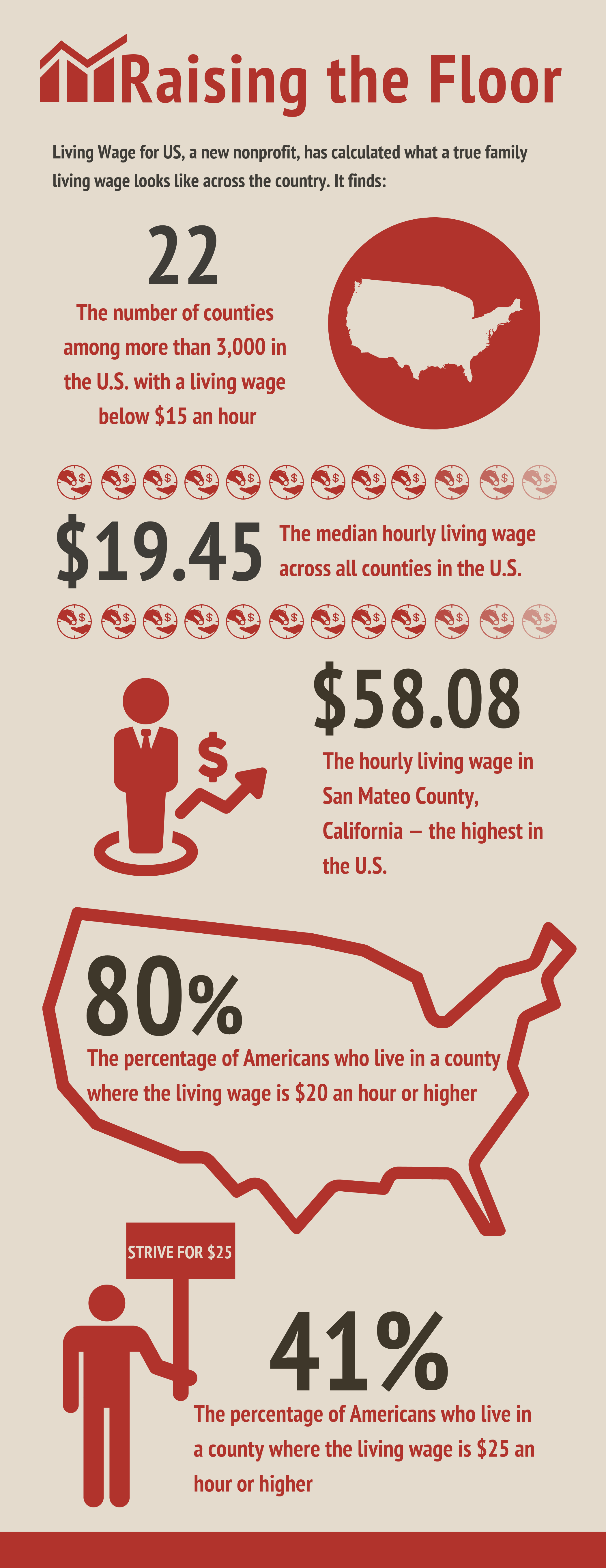The 50-100 Pay Gap
Are You Being Paid Enough to Live On? New Tool Aims to Answer That Question.
For US is designed to help businesses across the country determine if they are providing a real living wage.

In the spring of 2018, in her role as coordinator of the Global Living Wage Coalition, Michelle Murray found herself in Belize, thousands of miles from her home in New York, urging a banana grower to raise his workers’ pay.
As Murray would later recall the conversation, the farmer was receptive as to what he needed to do — but also perceptive about what she needed to do.
“I get it,” the grower told Murray. “I get why I should pay my workers a living wage. My question to you is, when my bananas are sold at the grocery store that’s down the street from you, are those workers making a living wage?”
The answer was obvious; the average pay for a grocery clerk in New York is $12 an hour. When Murray replied that they surely weren’t, the grower bore right in: “Well, why aren’t you doing anything in your own backyard?”
That stinging question provoked a little shame — “I felt hypocritical,” Murray says — and a lot of thinking and planning over the next three and a half years, the results of which are being unveiled today by Murray’s new organization, Living Wage for US.
The nonprofit has put together a program, dubbed For US, that is designed to help businesses across the country determine if they are providing a real living wage, figure out how to remedy the situation if they’re not and certify those who are. (Spoiler alert: With very few exceptions, $15 an hour doesn’t cut it, regardless of where you live.)
Even employers that want to do the right thing and pay their workers adequately, Murray notes, often don’t know where to turn. “What they’re struggling with is too little information,” she says. “They want clear guidance.”
Employees have seen their wages climbing as businesses try to regain their footing after the worst of the pandemic. But the cost of living also has soared, negating the bump in pay for many.
Aaron Seyedian is one of them. His Washington, D.C., house-cleaning company, which he founded in 2017, has always prided itself on treating its workers well, just as its name implies: Well-Paid Maids.
“The whole idea is to have a service that folks can feel good about using,” Seyedian says. Although the company charges more than many of its competitors — $199 to tackle a one-bedroom, one-bath apartment — Seyedian says consumers are willing to shell out a little more when they understand that by doing so, it allows his staff of 20 to be financially secure.
What’s more, by offering strong wages (along with medical, dental and vision plans, paid time off and a mileage reimbursement for driving to work), Seyedian says he has been able to attract productive employees while losing relatively few to turnover, and that translates into excellent service for his customers. “A virtuous cycle definitely exists,” he says.
Nonetheless, even Well-Paid Maids wasn’t paying a living wage as gauged by Murray and her team. As they perfected their model, they dug into Seyedian’s company, as well as several others that took part in an employer advisory panel. Their analysis prompted Well-Paid Maids to lift its starting wage from $17 an hour to $20.
“It’s really valuable to have a third party kick the tires on what you’re doing,” Seyedian says.
* * *
For US is being launched at a time when employees across the nation, especially those who are low paid, have seen their wages climbing as businesses try to regain their footing after the worst of the pandemic. But the cost of living also has soared, negating the bump in pay for many workers.
Labor market experts also caution that the basic structure of the economy, which led to decades of wage stagnation, hasn’t changed at all: In the interplay between workers and employers, business still has the upper hand. And meaningful actions that the government could take to even out that dynamic for the longer term, such as increasing the minimum wage or making it easier for workers to unionize, remain stalled.
Meanwhile, though, some power has shifted to workers for now, as strikes and resignations surge.
That has made it “the perfect moment for us,” Murray says, with dozens of businesses contacting her even before today’s official rollout. “They’re telling us, ‘It’s a difficult environment. We don’t know what to do to fix this. We need clear targets’” around pay to recruit and retain workers.
Not that there aren’t useful tools already out there. The best known is the MIT Living Wage Calculator, created in 2003 by Amy Glasmeier, a professor of economic geography, and Tracey Farrigan, a research economist at the U.S. Department of Agriculture.
“Companies seeking certification is an important next step in securing living wages for American families.”
~ Amy Glasmeier, co-creator of the MIT Living Wage Calculator
Glasmeier says she hears several times a day from companies seeking to use the MIT calculator to set wages for their frontline workers, and she often collaborates confidentially with businesses as they look to move their pay higher. Her framework is also used regularly by policymakers, as well as folks just trying to figure out what it costs to live in a particular area.
Murray, by contrast, has aimed her effort squarely at the business community. “Michelle did an amazing job” as she tailored her approach, Glasmeier says. “Companies seeking certification is an important next step in securing living wages for American families.”
Like the MIT calculator, For US is place-sensitive, basing someone’s cost of living on where they reside among the more than 3,000 counties spanning America. After all, you don’t need to earn nearly as much to make ends meet in Jackson County, Mississippi, as you do in, say, Marin County, California, outside San Francisco.
But because of its focus on employers, For US also has some crucial differences.
For one thing, rather than publish a range of living wages, which vary depending on whether someone is single with no kids or a breadwinner in a household with dependents, For US gives businesses one benchmark to shoot for. This is what it takes to achieve “a decent standard of living” for a home with two children and two adults — one who works full time and the other who works about three-quarters time (a figure derived from rates for labor force participation and part-time employment in the United States).

Locking in on this four-person measure wasn’t arbitrary. Consistent with widely accepted methodology used around the world, it is meant to ensure a wage floor can support the typical working family. And by giving businesses a solitary number to adhere to, rather than a handful of options, it can make the system more straightforward to implement.
Another key feature of For US is the way it credits employers for forms of compensation besides wages, including health coverage, a retirement plan and child care and transportation benefits. All of that goes into evaluating whether a company qualifies to be certified by For US as a “leading” living-wage employer. (Companies can attain a lower-tier certification by paying all of its workers at least $15 to $18 an hour, depending on where it has operations, and then increasing remuneration every year by inflation plus 3% until a family living wage is paid to everyone.)
Olympia Coffee, for example, will come out of the gate certified as a leading living-wage company, thanks not only to its pay — $15 an hour, plus tips, at its cafes in Seattle — but also its health insurance, paid leave policy and retirement-plan contributions.
After For US put the entire package through its rigorous assessment, Olympia Coffee had exceeded the living-wage threshold of $21.02 for King County, Washington, as well as the required amounts in the two other counties where it does business. The benefits “tipped us over the top,” says Richelle Parker, the company’s human resources manager.
For Olympia Coffee, which has 80 employees at seven locations, sustaining its For US certification from year to year is a worthy — and decidedly concrete — goal. “We believe that business should exist to do good in the world,” says Oliver Stormshak, the company’s CEO. “But that can sound grandiose. What does that mean? This is a way of holding ourselves accountable.”
For others, gaining certification will entail changes. Consider, for example, The Well Coffeehouse, a roaster and retailer with four stores in Tennessee and one in Indiana. A nonprofit social enterprise, The Well uses its revenues to build clean-water projects in the regions of Central America, Africa and Asia where it sources its coffee. It has been paying its baristas $8.50 an hour, which usually grows to between $16 and $18 once tips are included. But as it pursues certification with For US, The Well is mulling how to add a transportation allowance, extend paid time off and adjust wages for its employees in Indiana, where it costs more to live than in Tennessee.
Applying to For US has “opened my eyes to where we have gaps,” says Mike Lenda, CEO of The Well. “This will help us stretch.”
New York has one of the highest living wages in the country, largely due to the cost of child care, at $52.88 an hour.
In all, about a dozen businesses have hit their marks for certification by For US. Another 40 or so, including several large multinational corporations, are somewhere in the pipeline.
After an application is submitted, For US doesn’t audit anybody’s books. Instead, there is an online portal for workers to anonymously flag any problems they see, such as an employer claiming its compensation is more than it actually is. Murray says that when she was advocating for living wages abroad, this grievance mechanism proved to be effective.
“We know that mistakes will be made” on occasion by companies involved with For US, Murray says. “This keeps them honest.”
For Murray, part of the challenge in constructing For US has been to find the right balance between devising a formula that will help people “go beyond a subsistence wage to a true living wage” and not pushing things so far as to alienate businesses.
For example, For US includes, over and above what it costs to buy essentials, an extra 5% for “resilience” — the kind of cash cushion that many low-paid workers never have but is critical to deal with any kind of unexpected expense that may arise.
At the same time, For US doesn’t force employers interested in certification to clear the highest hurdle possible. If their workers can conceivably commute to their jobs from a lower-cost locale, that less expensive place is used to establish the living wage. For instance, New York has one of the highest living wages in the country, largely due to the cost of child care, at $52.88 an hour. But employers in Manhattan can use the living wage for the Bronx, $36.50, because that’s within the “commuting zone.”
“It’s fair,” says Elise Gould, a senior economist at the Economic Policy Institute, whose own family budget calculator helped to inform For US. “There is integrity to the whole process,” adds Gould, who crunched data for Murray and will continue to partner going forward.
* * *
Living Wage for US began as an initiative of Oxfam America before spinning out on its own. Oxfam and Uncharted, a social-impact accelerator, have contributed funding to get For Us off the ground. But Murray intends to make her organization financially viable on its own. It charges an application fee for certification — $250 for a business with less than $1 million in revenue, up to $10,000 for a corporation with more than $5 billion in revenue. Annual renewal runs between $300 and $40,000.
If For US catches on, it could represent a significant advance for the living-wage movement in America, which traces its origins to the 19th century and, in its modern incarnation, to a 1994 city ordinance in Baltimore.
Murray anticipates that she’ll be able to certify 600 employers nationwide, with a total of about 175,000 workers, over the next couple of years. Yet even if For US surpasses that scale, it is going to be extremely tough to make a dent in the national labor market, much less affect its overall trajectory. In the end, tens of millions of workers are stuck in low-wage jobs at employers that aren’t likely to go anywhere near For US.
“It’s hard,” says Chris Ellis, a senior director at MASS LBP, a Toronto consultancy that in 2012 spearheaded a campaign called Wagemark, which sought to certify businesses that maintained a “responsible wage ratio” between its highest-paid executives and frontline workers. Even though Wagemark generated quite a bit of media attention, few businesses signed up, and by 2013 it was discontinued. “The hoopla doesn’t relate to the uptake at all,” Ellis says.
Even company certification programs that are commonly viewed as successful touch just a tiny fraction of businesses. There are, for example, more than 1,350 B Corporations in the United States that “meet the highest standards of verified social and environmental performance, public transparency and legal accountability to balance profit and purpose.” But that’s barely a blip in the context of the more than 6 million employers in America. Similarly, there are about 39,000 LEED-certified, “green” commercial buildings around the country — less than 1% of all such structures.
And yet for every business that does get certified by For US, whether its headcount is in the dozens or hundreds or thousands, paying a family living wage may well be transformational for many of its workers.
“For those individuals, it matters,” says Gould. “That’s not to be discounted.”
And then there’s the signal it sends. Murray hopes that enough companies will use For US that it will show politicians that businesses can in fact pay a living wage and also flourish, thereby making it less fraught to mandate higher minimum wages at the local, state and federal levels. “We want to prove the case,” says Murray.
If For Us can pull that off, the payoff could be huge indeed.
Copyright 2021 Capital & Main

-

 Latest NewsDecember 8, 2025
Latest NewsDecember 8, 2025This L.A. Museum Is Standing Up to Trump’s Whitewashing, Vowing to ‘Scrub Nothing’
-

 Striking BackDecember 4, 2025
Striking BackDecember 4, 2025Home Care Workers Are Losing Minimum Wage Protections — and Fighting Back
-

 The SlickDecember 2, 2025
The SlickDecember 2, 2025Utility Asks New Mexico for ‘Zero Emission’ Status for Gas-Fired Power Plant
-

 Latest NewsDecember 1, 2025
Latest NewsDecember 1, 2025Accountable to No One: What 1990s L.A. Teaches Us About the Trump Resistance
-

 Dirty MoneyDecember 3, 2025
Dirty MoneyDecember 3, 2025Trump’s Anti-Climate Policies Are Driving Up Insurance Costs for Homeowners, Say Experts
-

 Child FarmworkersDecember 5, 2025
Child FarmworkersDecember 5, 2025To Protect Underage Farmworkers, California Expands Oversight of Field Conditions
-

 Column - State of InequalityDecember 4, 2025
Column - State of InequalityDecember 4, 2025Can California Claw Back Some Medi-Cal Care?
-

 Latest NewsDecember 10, 2025
Latest NewsDecember 10, 2025Capital & Main, L.A. Times Win Sidney Award for Reporting on Child Farmworkers

